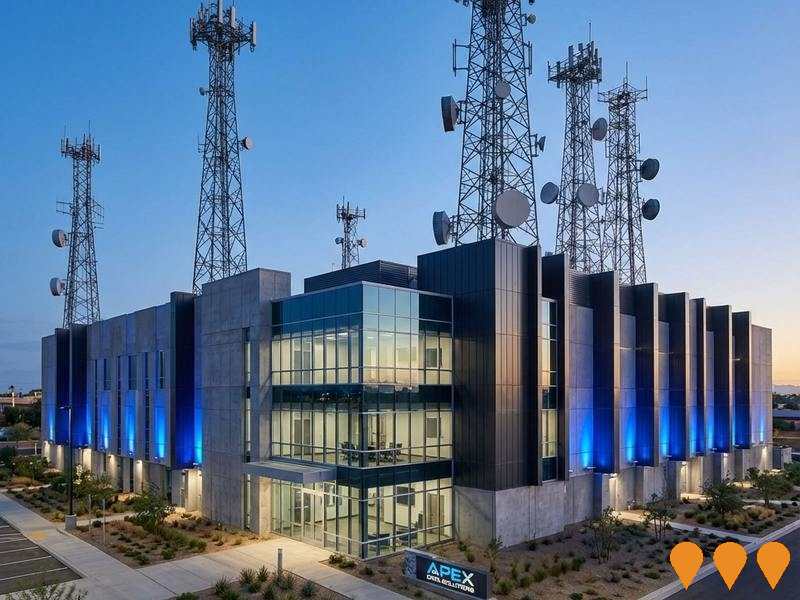Chart Color Schemes
est. as @ -- *
ABS ERP | -- people | --
2021 Census | -- people
Sales Activity
Curious about local property values? Filter the chart to assess the volume and appreciation (including resales) trends and regional comparisons, or scroll to the map below view this information at an individual property level.
Find a Recent Sale
Sales Detail
Population
Bega - Tathra has seen population growth performance typically on par with national averages when looking at short and medium term trends
Bega - Tathra's population, as of August 2025, is approximately 9,161, reflecting a 3.3% increase from the 8,872 people recorded in the 2021 Census. This growth is inferred from an estimated resident population of 9,017 in June 2024 and an additional 207 validated new addresses since the Census date. The population density stands at 49 persons per square kilometer. Bega - Tathra's growth rate of 3.3% since the 2021 census exceeds that of the SA3 area (2.3%), positioning it as a growth leader in the region. Overseas migration contributed approximately 50.0% of overall population gains during recent periods. AreaSearch uses ABS/Geoscience Australia projections for each SA2 area, released in 2024 with 2022 as the base year, and NSW State Government's SA2 level projections for areas not covered by this data, released in 2022 with 2021 as the base year.
Growth rates by age group are applied to all areas from these aggregations for years 2032 to 2041. Based on projected demographic shifts, a population increase just below the median of national regional areas is expected, with Bega - Tathra's population projected to increase by 747 persons to reach approximately 9,908 by 2041, reflecting an overall increase of 6.5% over the 17-year period.
Frequently Asked Questions - Population
Development
Residential development activity is slightly higher than average within Bega - Tathra when compared nationally
Bega - Tathra has experienced around 56 dwelling approvals per year on average over the past five financial years, from FY21 to FY25. In total, 284 homes were approved during this period, with an additional 13 approved in FY26 so far. On average, these new constructions have resulted in approximately 0.9 new residents per year.
The average construction value of new homes is $496,000. This financial year has seen $32.6 million in commercial approvals, indicating strong local business investment. Compared to the rest of NSW, Bega - Tathra has recorded a slightly higher level of construction activity, with 10.0% more approvals per person over the past five years. The new building activity shows a shift towards higher-density living, with 49.0% detached houses and 51.0% attached dwellings approved. This change reflects decreasing availability of developable sites and evolving lifestyle preferences.
With around 197 people per dwelling approval, Bega - Tathra exhibits characteristics of a low density area. Future projections suggest that the region will add approximately 595 residents by 2041. Based on current development patterns, new housing supply should meet demand, providing favorable conditions for buyers and potentially facilitating population growth beyond current projections.
Frequently Asked Questions - Development
Infrastructure
Bega - Tathra has moderate levels of nearby infrastructure activity, ranking in the 44thth percentile nationally
The performance of a region is significantly influenced by changes in local infrastructure, major projects, and planning initiatives. AreaSearch has identified three projects that are expected to impact this area. Notable projects include the Bega Sewage Treatment Plant Upgrade, South Bega Urban Land Release Planning Proposal, Barrack Street Bega Redevelopment Project, and Wolumla Structure Plan. The following list provides details on those projects likely to be most relevant.
Professional plan users can use the search below to filter and access additional projects.
INFRASTRUCTURE SEARCH
 Denotes AI-based impression for illustrative purposes only, not to be taken as definitive under any circumstances. Please follow links and conduct other investigations from the project's source for actual imagery. Developers and project owners wishing us to use original imagery please Contact Us and we will do so.
Denotes AI-based impression for illustrative purposes only, not to be taken as definitive under any circumstances. Please follow links and conduct other investigations from the project's source for actual imagery. Developers and project owners wishing us to use original imagery please Contact Us and we will do so.
Frequently Asked Questions - Infrastructure
South Bega Urban Land Release Planning Proposal
Council-led planning proposal to rezone approximately 279 hectares of land south of Bega to facilitate around 2,200 new homes across three new neighbourhoods, with supporting retail centres, commercial areas, local shops, public spaces, and infrastructure including roads, utilities and open spaces. The proposal follows the adopted Bega Structure Plan 2024 and includes a Draft Affordable Housing Contribution Scheme proposing 2% of land value increase be reinvested into affordable housing. The development will offer a variety of densities, lot sizes and dwelling types to meet the needs of first home buyers, families, single-person households, seniors and key workers. Currently on public exhibition with feedback closing November 2, 2025, and final decision expected by July 2026.

Low and Mid-Rise Housing Policy
State-wide NSW planning reforms via amendments to the State Environmental Planning Policy to enable more diverse low and mid-rise housing (dual occupancies, terraces, townhouses, manor houses and residential flat buildings up to 6 storeys) in well-located areas within 800 m of selected train, metro and light-rail stations and town centres. Stage 1 (dual occupancies in R2 zones statewide) commenced 1 July 2024. Stage 2 (mid-rise apartments, terraces and dual occupancies near stations) commenced 28 February 2025. Expected to facilitate up to 112,000 additional homes over the next five years.
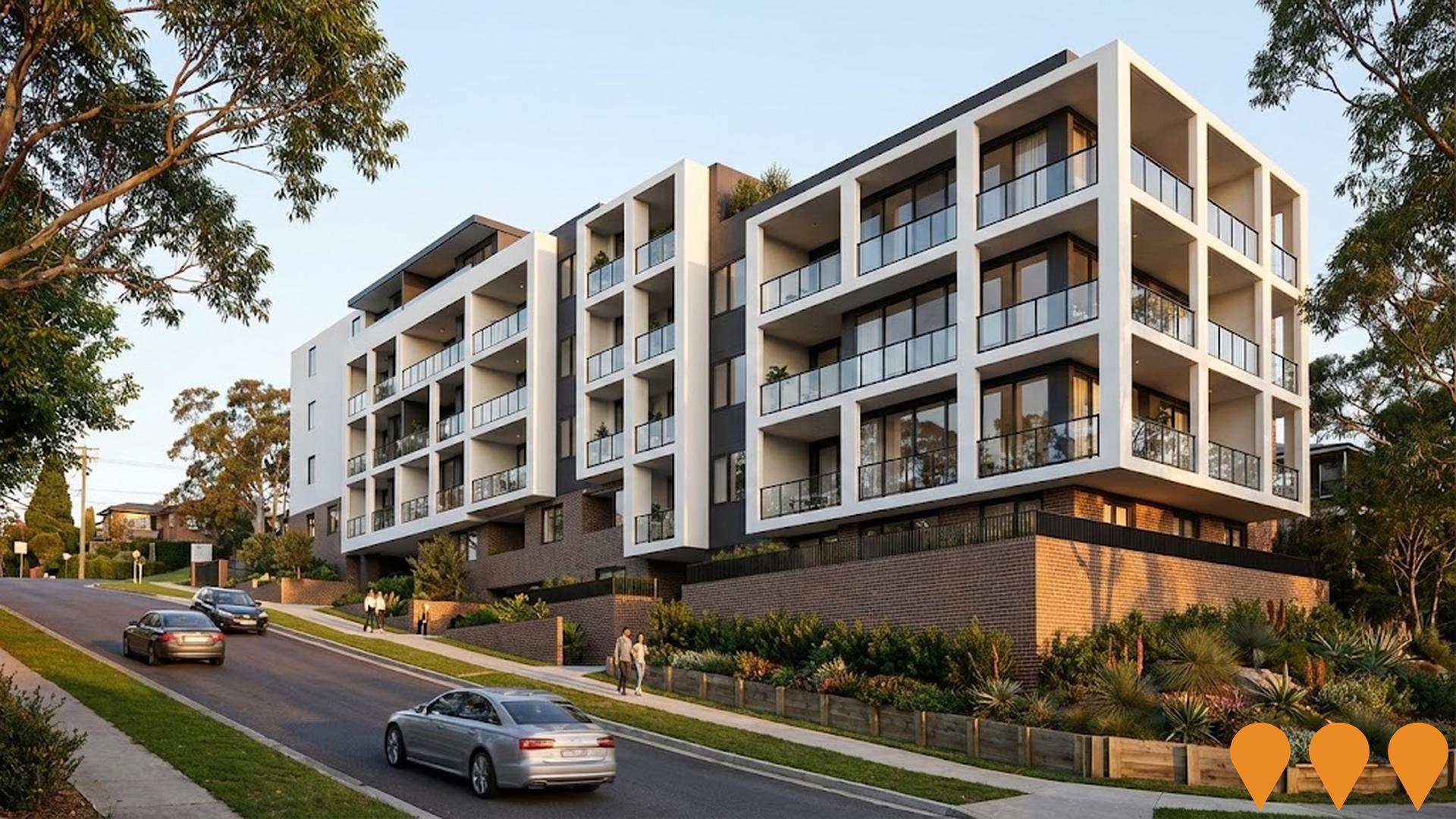
Victorian Renewable Energy Zones
VicGrid, a Victorian Government agency, is coordinating the planning and staged declaration of six proposed onshore Renewable Energy Zones (plus a Gippsland shoreline zone to support offshore wind). The 2025 Victorian Transmission Plan identifies the indicative REZ locations, access limits and the transmission works needed to connect new wind, solar and storage while minimising impacts on communities, Traditional Owners, agriculture and the environment. Each REZ will proceed through a statutory declaration and consultation process before competitive allocation of grid access to projects.
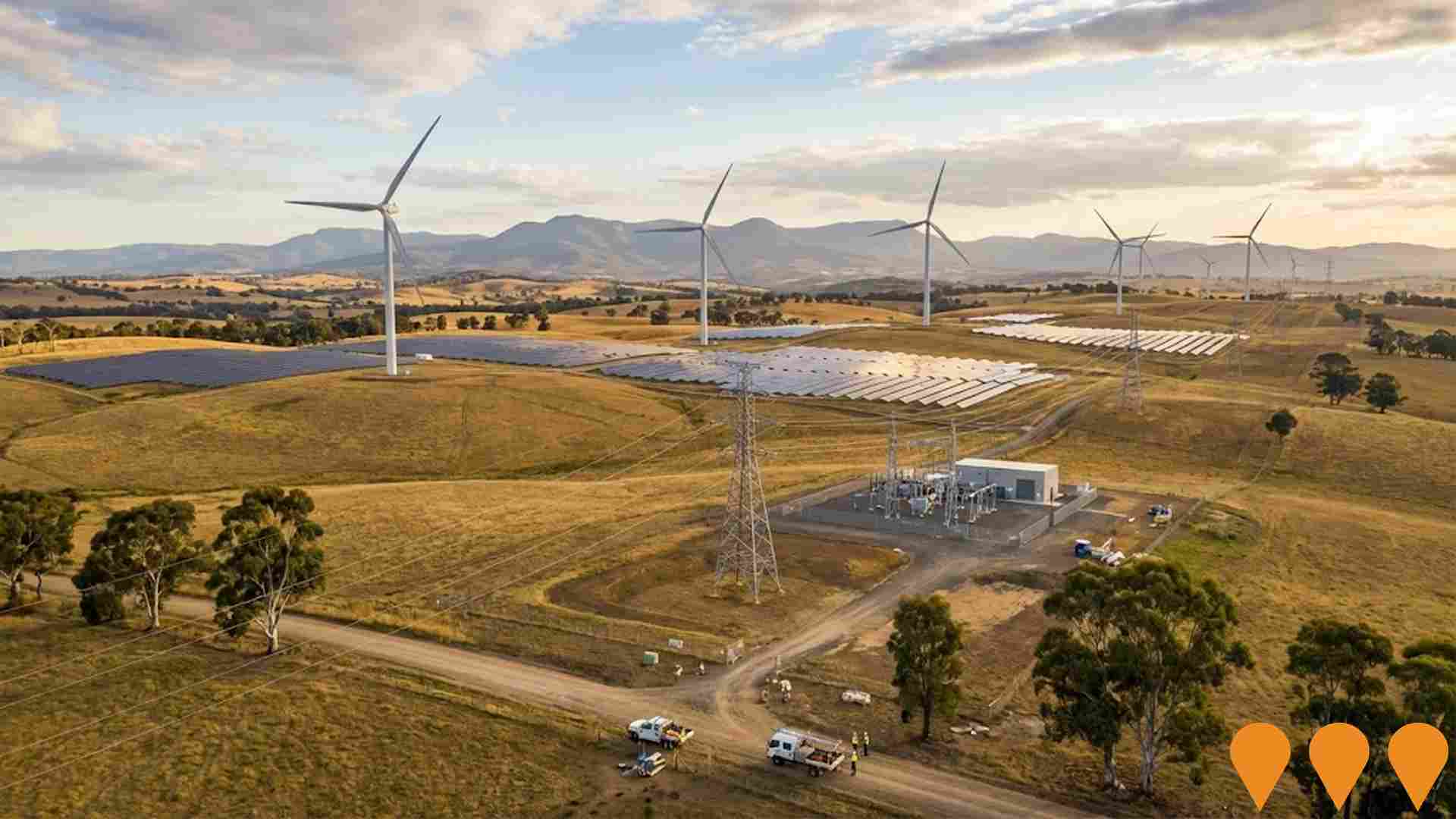
NSW Renewable Energy Zones (REZ) Program
NSW is delivering five Renewable Energy Zones (Central-West Orana, New England, South West, Hunter-Central Coast and Illawarra) to coordinate new wind and solar generation, storage and high-voltage transmission. The program is led by EnergyCo NSW under the Electricity Infrastructure Roadmap. Construction of the first REZ (Central-West Orana) transmission project commenced in June 2025, with staged energisation from 2028. Across the program, NSW targets at least 12 GW of new renewable generation and 2 GW of long-duration storage by 2030.
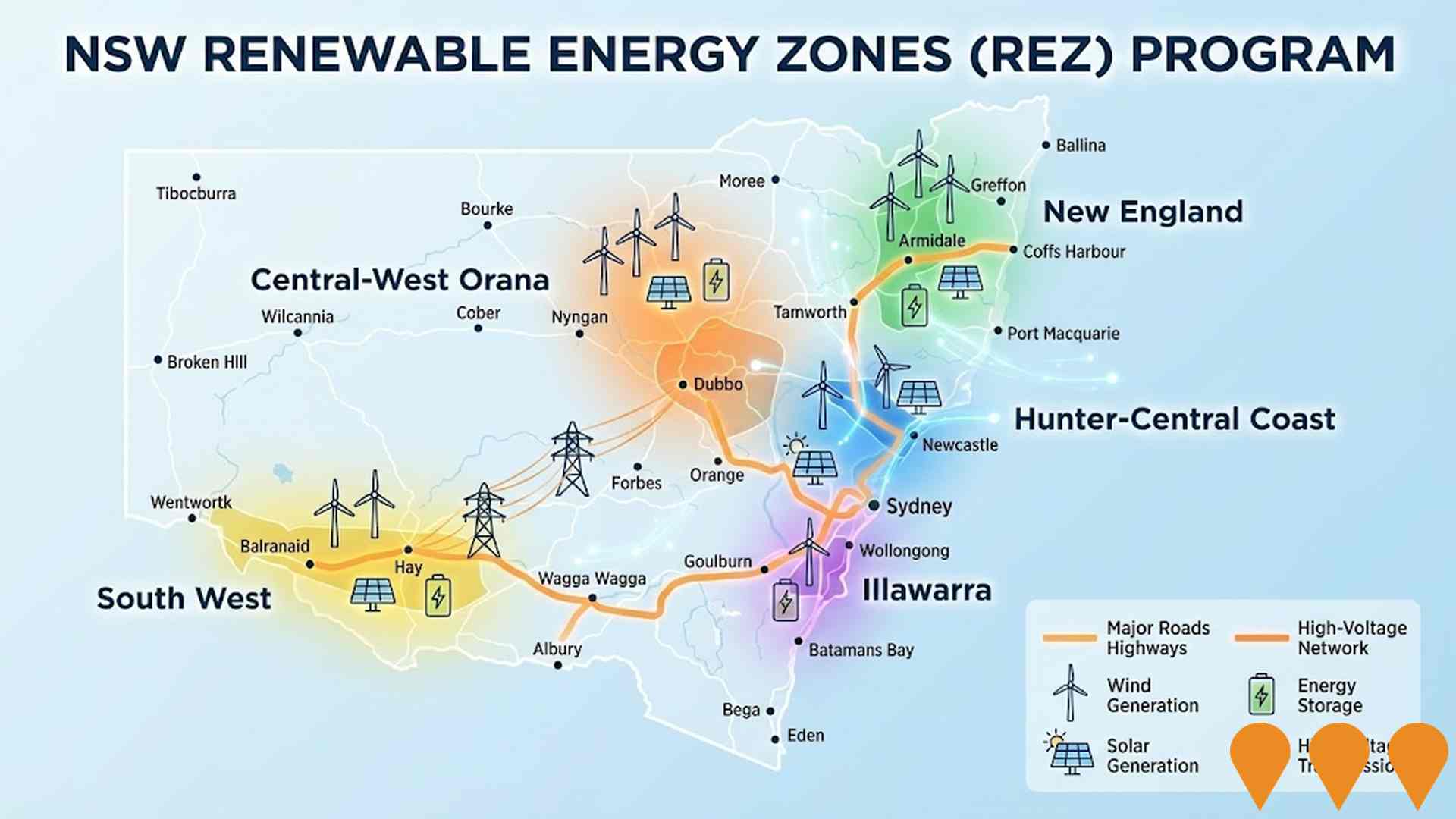
Bega Sewage Treatment Plant Upgrade
Comprehensive upgrade to the Bega Sewage Treatment Plant to expand treatment capacity for future population growth, meet NSW Environment Protection Agency operational licence requirements, protect the facility from flooding and sea level rise impacts, improve wet weather flow management, enhance sludge handling and stabilization capacity, and install solar power to reduce the carbon footprint of the site. The project includes infrastructure expansion to the west on council-owned land adjacent to the existing plant.

Barrack Street Bega Redevelopment Project
Transformation of 7.7 hectares of former Bega TAFE site into approximately 100 new homes including 68 private market homes, 8 affordable homes, and 24 social homes. The development includes a 20-unit complex of smaller accessible homes designed for the region's aging population. The project addresses critical housing shortages in Bega Valley, which has one of the lowest rental vacancy rates in NSW at 0.24%. Site demolition completed in 2024, with public exhibition planned for late 2025 and construction expected to commence in 2026.

Wolumla Structure Plan
Adopted structure plan providing a strategic framework for the development of approximately 1,096 new dwellings across three major land holdings in Wolumla. The plan guides infrastructure provision including transport networks, utilities, and community facilities to integrate new residential areas with the existing village. Council secured $50,380 in funding in July 2025 to prepare an infrastructure contributions plan. The development will effectively triple Wolumla's population over an estimated 25-year timeframe and addresses housing shortage in the Bega Valley Shire.
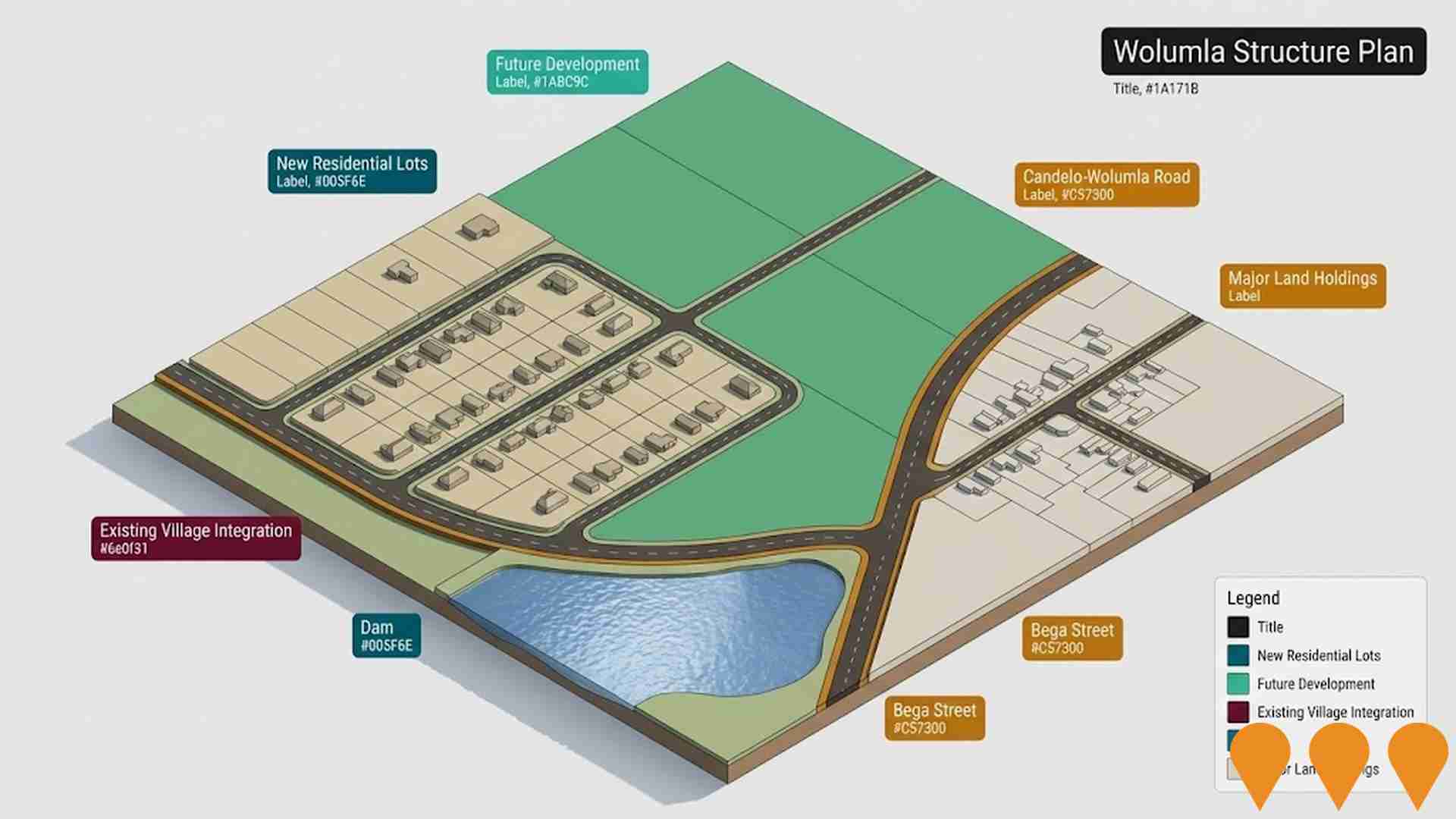
NSW Heavy Vehicle Rest Stops Program (TfNSW)
Statewide Transport for NSW program to increase and upgrade heavy vehicle rest stopping across NSW. Works include minor upgrades under the $11.9m Heavy Vehicle Rest Stop Minor Works Program (e.g. new green reflector sites and amenity/signage improvements), early works on new and upgraded formal rest areas in regional NSW, and planning and site confirmation for a major new dedicated rest area in Western Sydney. The program aims to reduce fatigue, improve safety and productivity on key freight routes, and respond to industry feedback collected since 2022.
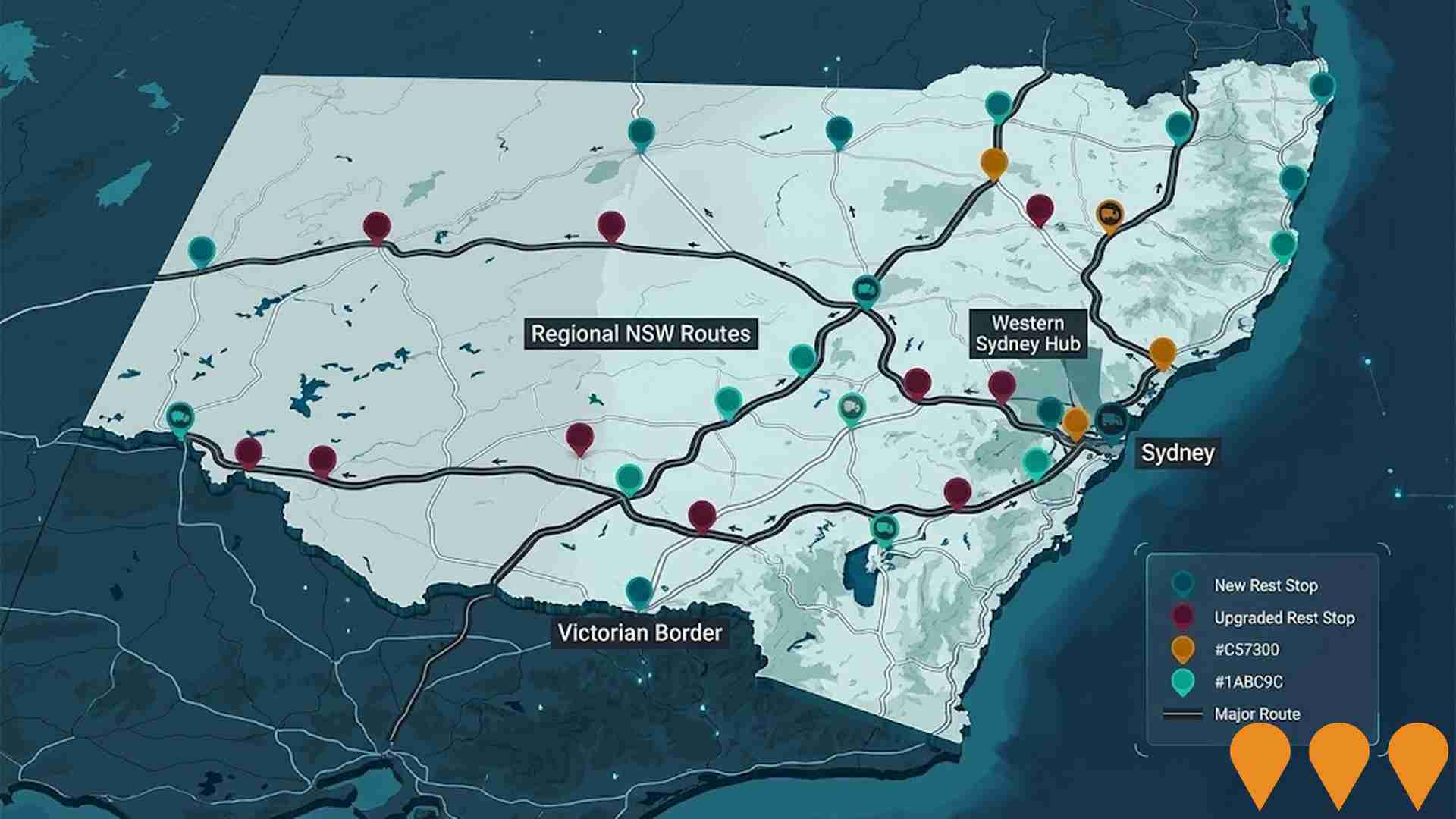
Employment
AreaSearch assessment indicates Bega - Tathra faces employment challenges relative to the majority of Australian markets
Bega - Tathra has a skilled workforce with prominent essential services sectors. As of June 2025, the unemployment rate is 4.6%.
There are 4,080 residents employed, with an unemployment rate of 0.9% higher than Rest of NSW's rate of 3.7%. Workforce participation is lower at 54.2%, compared to Rest of NSW's 56.4%. Key employment sectors include health care & social assistance, retail trade, and construction. Health care & social assistance shows strong specialization with an employment share 1.3 times the regional level.
Conversely, mining has lower representation at 0.2% versus the regional average of 2.5%. The worker-to-resident ratio is 0.6, indicating above-norm local employment opportunities. From June 2024 to June 2025, labour force decreased by 3.6%, while employment declined by 4.6%, leading to a 1.0 percentage point rise in unemployment rate. Rest of NSW saw an employment decline of 0.1%, labour force growth of 0.3%, and unemployment rising by 0.4 percentage points. National employment forecasts from Jobs and Skills Australia, published in May 2025, project national employment growth of 6.6% over five years and 13.7% over ten years. Applying these projections to Bega - Tathra's employment mix suggests local growth of approximately 6.5%% over five years and 13.8% over ten years.
Frequently Asked Questions - Employment
Income
The area's income levels rank in the lower 15% nationally based on AreaSearch comparative data
AreaSearch's aggregation of ATO data released for financial year 2022 shows Bega - Tathra had a median income among taxpayers of $43,114 and an average level of $52,812. This is below the national average. Rest of NSW had levels of $49,459 (median) and $62,998 (average). Based on Wage Price Index growth of 12.61% since financial year 2022, current estimates for Bega - Tathra would be approximately $48,551 (median) and $59,472 (average) as of September 2025. Census 2021 income data shows household, family and personal incomes in Bega - Tathra all fall between the 18th and 29th percentiles nationally. In terms of income distribution, 29.0% of individuals earn between $1,500 and $2,999, reflecting regional patterns where 29.9% occupy this range. After housing costs, 85.3% of income remains, ranking at the 21st percentile nationally.
Frequently Asked Questions - Income
Housing
Bega - Tathra is characterized by a predominantly suburban housing profile, with a higher proportion of rental properties than the broader region
In Bega - Tathra, as per the latest Census evaluation, 87.8% of dwellings were houses, with the remaining 12.1% consisting of semi-detached homes, apartments, and other types. In contrast, Non-Metro NSW had 84.3% houses and 15.7% other dwellings. Home ownership in Bega - Tathra stood at 43.9%, with mortgaged properties at 29.0% and rented dwellings at 27.1%. The median monthly mortgage repayment was $1,517, aligning with Non-Metro NSW's average, while the median weekly rent was $320, also matching Non-Metro NSW's figure. Nationally, Bega - Tathra's mortgage repayments were significantly lower than the Australian average of $1,863, and rents were substantially below the national figure of $375.
Frequently Asked Questions - Housing
Household Composition
Bega - Tathra features high concentrations of lone person households, with a higher-than-average median household size
Family households comprise 65.9% of all households, including 22.7% couples with children, 30.5% couples without children, and 12.0% single parent families. Non-family households make up the remaining 34.1%, with lone person households at 31.3% and group households comprising 2.9% of the total. The median household size is 2.3 people, larger than the Rest of NSW average of 2.2.
Frequently Asked Questions - Households
Local Schools & Education
Educational attainment in Bega - Tathra aligns closely with national averages, showing typical qualification patterns and performance metrics
In Bega-Tathra trail region, 23.7% of residents aged 15 or above hold university degrees, compared to NSW's 32.2%. This indicates potential for educational development. Bachelor degrees are the most common (16.5%), followed by postgraduate qualifications (4.2%) and graduate diplomas (3.0%). Vocational credentials are also prevalent, with 38.3% of residents holding them; advanced diplomas account for 9.4%, while certificates make up 28.9%.
Educational participation is high at 27.7%, including primary education (11.2%), secondary education (7.6%), and tertiary education (2.7%). There are eight schools operating in the region, educating approximately 2,024 students with typical Australian school conditions (ICSEA: 1006) offering balanced educational opportunities. The schools include five primary, one secondary, and two K-12 institutions. Bega-Tathra functions as an education hub with 22.1 school places per 100 residents, significantly above the regional average of 12.7, attracting students from surrounding communities.
Frequently Asked Questions - Education
Schools Detail
Nearby Services & Amenities
Transport
Transport servicing is low compared to other areas nationally based on assessment of service frequency, route connectivity and accessibility
Transport analysis indicates 210 active stops operating within Bega-Tathra area as of March 2023. These stops offer bus services via 43 individual routes, collectively facilitating 665 weekly passenger trips. Transport accessibility is rated good with residents typically located 203 meters from the nearest stop.
Service frequency averages 95 trips per day across all routes, equating to approximately three weekly trips per individual stop.
Frequently Asked Questions - Transport
Transport Stops Detail
Health
Health performance in Bega - Tathra is well below average with prevalence of common health conditions notable across both younger and older age cohorts
Bega - Tathra faces significant health challenges with high prevalence of common conditions across both younger and older age groups. Private health cover stands at approximately 47%, covering around 4,278 people, compared to the national average of 55.3%.
The most prevalent medical conditions are arthritis (11.1%) and mental health issues (10.0%). About 61.3% of residents report no medical ailments, slightly higher than the Rest of NSW's 59.6%. The area has a lower proportion of residents aged 65 and over at 25.8%, or around 2,360 people, compared to the Rest of NSW's 31.7%.
Frequently Asked Questions - Health
Cultural Diversity
Bega - Tathra is considerably less culturally diverse than average when assessed alongside AreaSearch's national rankings for language and cultural background related metrics
Bega-Tathra has a cultural diversity index below the average, with 90.3% of its population being citizens, 89.6% born in Australia, and 95.8% speaking English only at home. Christianity is the predominant religion in Bega-Tathra, accounting for 46.7% of the population. Notably, Judaism is overrepresented compared to the rest of NSW, with 0.1% of Bega-Tathra's population identifying as such.
The top three ancestry groups are Australian (32.7%), English (31.2%), and Irish (10.0%). There are also notable differences in the representation of German (4.1% vs regional 3.6%), Australian Aboriginal (3.3% vs 3.6%), and Dutch (1.4% vs 1.4%) ethnic groups compared to the region's averages.
Frequently Asked Questions - Diversity
Age
Bega - Tathra hosts an older demographic, ranking in the top quartile nationwide
Bega-Tathra has a median age of 46, which is higher than Rest of NSW's figure of 43 and significantly higher than Australia's national norm of 38. The 65-74 age group makes up 14.0% of Bega-Tathra's population compared to Rest of NSW, while the 15-24 cohort is less prevalent at 9.6%. Post-2021 Census data shows that the 0-4 age group has grown from 4.9% to 5.9%. Conversely, the 55-64 cohort has declined from 15.9% to 13.9%. By 2041, Bega-Tathra's age composition is expected to shift notably. The 75-84 group is projected to grow by 39%, reaching 1,110 people from 797. Those aged 65 and above are expected to comprise 52% of the population growth, while declines are projected for the 65-74 and 15-24 cohorts.

